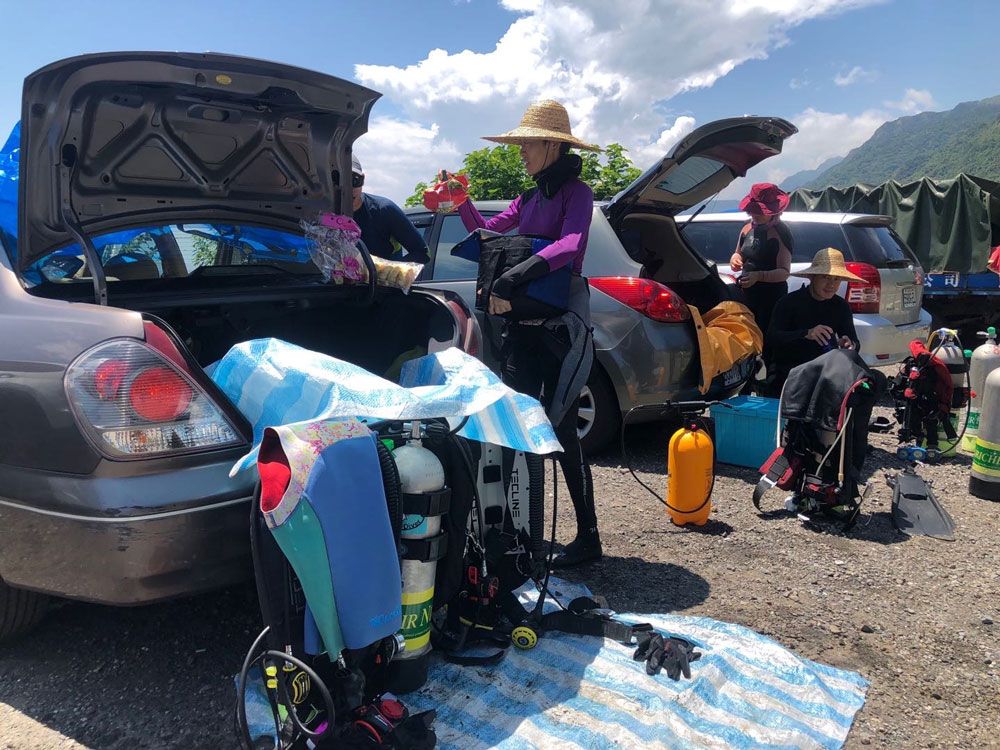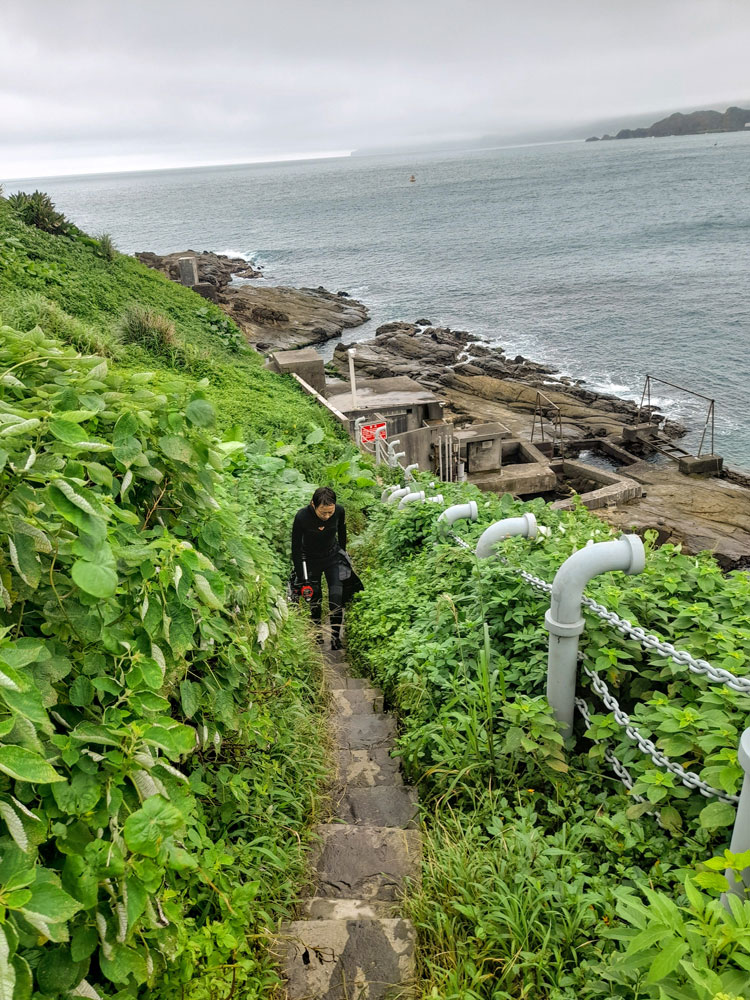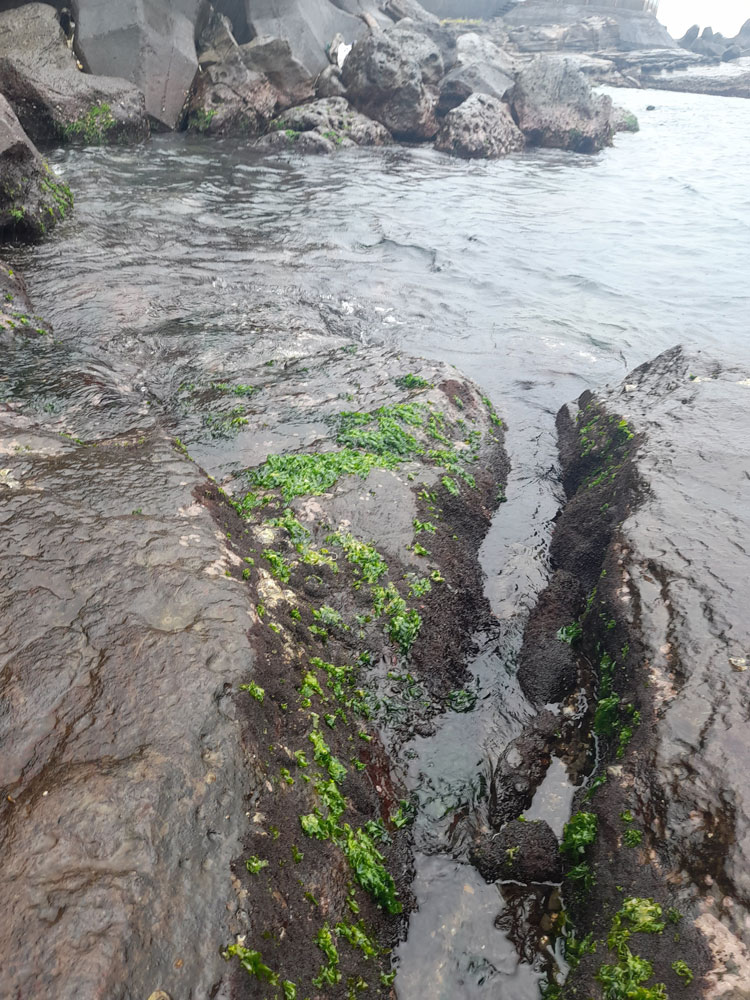Dive Travels
Shore diving in Taiwan: challenges and adaptations in a unique environment
Saturday morning 5:45 am, the alarm rings. With a groan, Emily (loosely based on a real person) turns over in bed, fumbles for the off button, and gets up. After a quick breakfast, she packs a cooler with snacks and plenty of drinking water, takes the dolly she loaded the night before with her box of dive gear and camera, closes the door of her Taipei apartment behind herself and rides the elevator down.
Traffic is still low this early in the day, and the drive to the north-east coast via the mountain highways takes her only an hour. On the coastal road, she does a few quick stops to take note of the sea conditions. Looks like a good day, with only mild surge and current, as predicted by the weather app.
At the fill station, Emily’s friends are already waiting. They load up their cars with the nitrox cylinders they ordered the day before and decide to go diving at Canyons, one of the less busy sites on weekends. It’s a little difficult to get to, but someone spotted a few pretty special nudibranchs there the week before; maybe they can find them and get some good shots.
When the divers pull into the parking lot at the top of the cliff, the day is already hot. Glad she remembered to soak her wetsuit and at the fill station, Emily gears up, clipping her fins and camera to D-rings on her BCD harness to have her hands free for climbing. After the pre-dive checks and a final swig of water, the team is ready to go.
The narrow trail down the cliff is still muddy from last week’s rain, and Emily curses under her breath as she almost slips. After reaching the bottom, the divers still need to walk a couple hundred meters across the craggy tidal flat before they reach the jump point, a big rock jutting out into the ocean. Everybody is feeling the heat now and eager to be in the water.
Emily re-checks her cylinder valve and pressure gauge, puts her mask on, and gives her BCD a quick puff from the inflator button. Fins in hand, she carefully steps out onto the slippery rock. The first dive of the day is about to begin.
Most ocean dives happen from boats, for a variety of reasons: Many dive sites are too far from shore to be reached any other way, and even in popular locations where diving from the beach would in theory be possible, boats are often used to provide an added layer of safety and, not least, convenience. We’re doing this for fun, after all. Shore dives “on the house reef” are used mainly for training new divers and perhaps the occasional night dive, when the boat crews are off work.
As a result, shore diving is treated as an inferior second option to boat diving in most places. This attitude extends to diver training: While most recreational training agencies offer a “boat diving” specialty course, there is no specialized training to help divers become more competent at operating from shore. This is somewhat ironic, since boat diving is arguably a lot easier and less physically demanding than the alternative.
Taiwan is one the places in the world where shore diving is the rule rather than the exception, and pandemic travel restrictions kicked things into high gear – over the past three years, you were either diving locally, or you weren’t diving. The particular challenges presented by local sites have made Taiwanese divers quite skilled at shore diving and led to a number of unique adaptations to equipment and practices. This article presents some of these challenges and adaptations.

Dive preparations in a roadside parking lot on Taiwan’s north-east coast
Site selection
Two important considerations specific to shore diving are access to the water and safe entry/exit. A dive site needs to have parking within a reasonable walking/climbing distance (determined by diver fitness) and offer a way of getting into and out of the water safely. Waves and rocks can be a very unpleasant combination. The other enemy of shore divers is current, since a lack of boat support means that divers usually can’t afford to drift from their exit point. Good shore divers make it a habit to diligently check the sea conditions, both visually and using online weather services.
Equipment and practices
Outside of training, shore diving in northern Taiwan typically isn’t organized by professional operators. Instead, similar to traditional European club diving, small groups of like-minded divers simply pick up cylinders from their local fill station and drive to their site for the day. Equipment setup typically happens in a roadside parking lot, followed by a short hike down the cliff and across the tidal flats to the ocean.
Here’s where some of the gear adaptations come in: Pavilions to protect against the intense sunlight, carabiners and bolt snaps to attach fins and cameras to the BCD so people can use their hands for climbing, and felt-soled boots for better traction on rocks that are slippery with wet, slimy algae.

“The Wall”, a dive site near the town of Yilan, seen from the top of the cliff

Some dives involve a bit of a hike.

Forget rock boots. In order to handle this…

…you need this.
Water entry and exit
The combination of a rocky shore with waves or surge means that you can’t simply enter and exit the water anywhere you like. The best entry points are usually rocky outcroppings where the water is deep enough for a giant stride. In many places, the “platform” to jump from doesn’t offer secure enough footing to put your fins on, and divers frequently opt to put on their fins in the water. This has to be done quickly – a diver without fins is a plaything for the waves, and getting washed up against the rocks is a quick ticket to the land of cuts and bruises.
Most divers therefore use fins with steel spring heel straps. They are non-adjustable, can easily be put on with one hand and don’t need to be tightened, saving valuable time.
Getting into the water is usually easier than getting out. Exit points need to be flat enough for divers to get to their feet. Surge is usually more significant where the water is shallow, so again, timing is key – wait for the surge to wash you to where you can take off your fins, get to your feet, and get out of there before you get pulled back into the ocean. Many divers carry a pair of cheap work gloves in their BCD or thigh pocket to protect their hands against barnacle cuts when climbing out of the water.
Keeping it simple
In the water, things are a little easier, but there are some special considerations. Dive plans for shore diving need to be relatively conservative because there is no boat to bail you out if things go sideways. Because of logistics, most shore dives are conducted on a single tank, sometimes with a smaller tank as an independent gas supply for safety. Because of the need to carry gear across difficult terrain, dives with doubles and deco tanks are difficult to pull off except for physically strong and dedicated divers. Even then, you want to think twice about doing significant deco directly before a strenuous water exit followed by a hike up a cliff. Staying more or less within recreational limits is usually the best choice even for those who are trained to higher levels.
Navigation and gas planning
Because of the need to finish the dive at a specific exit point (and the lack of a boat to pick you up if you don’t), navigation plays a more important role in shore diving than in most boat dives. Compasses and detailed dive site maps (shared widely within the community) are key pieces of equipment. New sites should be approached using a process of progressive familiarization to minimize the risk of getting lost, and gas planning (click the link to read more on the subject) should allow for the possibility of delays and surprise currents.
At best, running low on gas due to a navigation error and being forced to surface away from shore will earn you a “swim of shame” and the gentle mockery of your peers. At worst, you’ll be adrift in a surface current and have to rely on a fishing boat or the coast guard to pick you up… and the mockery might be less gentle.
|
A combination of typically bad visibility and unique sea life make Northern Taiwan a paradise for macro photographers.
Photo credits: Wesley Oosthuizen
 From the left: Squat lobster (Galathea sp.), Harlequin shrimp (Hymenaocera picta), Dragon moray (Enchelycore pardalis), Rhinopias frondosa scorpionfish
|
Author’s note: At the time I first made contact with the Taiwanese dive scene many years ago, I considered myself fairly competent in the water. However, I quickly discovered that I was quite unused to the challenges of tough shore dives. I have Emily and other friends to thank for showing me the ins and outs of the DIY way of diving without trip organizers, boat operators, or resorts. There are few things more exciting than discovering a new way of looking at something you love, opening your mind, and learning new skills, and I hope this article inspires some of its readers to try out new ways of exploring the underwater world.
About the author
Tim Blömeke teaches technical and recreational diving in Taiwan and the Philippines. He is also a freelance writer and translator, as well as a member of the editorial team of Alert Diver. For questions, comments, and inquiries, you can contact him via his blog page or on Instagram.


